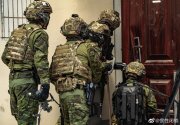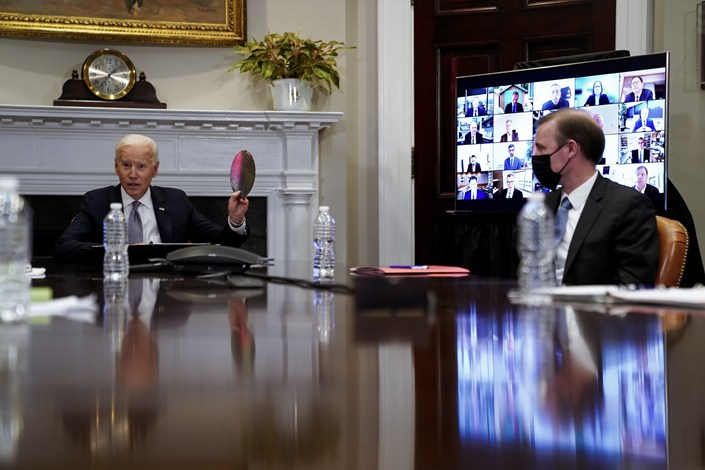Long but must read about the Biden administration global semiconductor strategy.
-------------------------------------------------------------------
Analysis: Washington Will Rethink Its Foreign Chip Strategy
(Oxford Analytica) — The U.S. Commerce Department’s recent request for firms involved in the global semiconductor supply chain to submit information about their business operations, backed by threats of compulsion in the event of non-compliance, has drawn opposition from key foreign companies such as TSMC and Samsung, supported by their governments. Follow-on action from Washington and responses from foreign actors will shape the U.S. government’s adversarial policy towards China in semiconductors and other strategic technologies.
What next
The Biden administration will likely scale down ambitions for an international “united front” against China in strategic technologies, at least in highly transnational industries such as semiconductors where foreign cooperation is essential. Such reduced ambition will likely generate opposition within the United States, where a “Make in America” industrial policy approach to economic revitalization and hostility towards the perceived threat that China presents to U.S. security have become a potent political combination.
Subsidiary Impacts
• The Biden administration will likely conclude that broad-based diversion of the semiconductor supply chain away from China is not feasible.
• The United States will rely on export controls and political pressure to prevent diffusion to China of cutting-edge chip technologies.
• The United States will focus on persuading foreign semiconductor leaders to help develop U.S. capabilities, thereby staying ahead of China.
• Washington will focus on less direct approaches to strategic technology competition with China, notably technical standards-setting.
• Industry leaders in the semiconductor supply chain worldwide will continue expanding business in China in less politically sensitive areas.
Analysis
In June, the U.S. government published findings from its 100-Day Reviews for four products, including semiconductors, that addressed President Joe Biden’s Executive Order to assess and strengthen the resilience of critical supply chains.
Among the recommendations were to “target and implement export controls that can support policy actions to identify and address vulnerabilities in the semiconductor manufacturing and advanced packaging supply chain,” and “make efforts to collaborate and coordinate with key supplier allies and partners on effective multilateral controls.”
With reference to these findings, the Commerce Department in September issued a formal Request For Information (RFI) for submissions from companies across the global semiconductor supply chain that addressed a list of questions concerning their business.
With reference to these findings, the Commerce Department in September issued a formal Request For Information (RFI) for submissions from companies across the global semiconductor supply chain that addressed a list of questions concerning their business.
Secretary of Commerce Gina Raimondo said that if these voluntary submissions were unsatisfactory, “we have other tools ... that require them to give us data.” She subsequently confirmed that this referred to the Defense Production Act, used by Presidents Donald Trump and Biden in response to the global coronavirus pandemic. Submissions closed on Nov. 8.
Objections
Firms from Taiwan and South Korea in particular, alongside their governments, expressed concerns about disclosing confidential data in response to some of the listed questions. One question, for instance, asks that they “list each product’s top three current customers and the estimated percentage of that product’s sales accounted for by each customer.” Full compliance with the RFI presented firms with the prospect of breaching legal obligations and of sensitive data being leaked to U.S. competitors.
Foreign firms are also likely to have suspected that the RFI was aimed at identifying their Chinese clients, so that these could be targeted by U.S. export controls and other measures designed to cut China off from leading-edge semiconductor technologies, which remain generally dominated by non-Chinese companies.
China is a critical market for global industry leaders throughout the semiconductor supply chain, given its concentration of electronics manufacturing and fast-growing markets.
By one estimate, in 2020 China assembled over one-third of the world’s electronic devices and was the second-largest final consumption market (after the United States) for electronic devices embedded with semiconductors.
U.S.-China context
These concerns are well founded given the increasing orientation of U.S. policy and politics towards strategic technology competition with China, and the concomitant rise of an ‘America First’-style industrial policy.
U.S. semiconductor firms may receive USD52bn in support from the draft U.S. Innovation and Competition Act, which in its original conception expressly targeted China and has been endorsed by Biden as central to a “competition to win the 21st century.”
Senator Josh Hawley recently introduced draft legislation – the “Make in America to Sell in America Act” -- that imposes local-content requirements in sectors deemed critical to national security and the protection of the U.S. strategic industrial base.
In this context, the response of foreign industry leaders and their governments to the September RFI was a test of attitudes towards supporting U.S. priorities concerning China. Key firms such as TSMC and Samsung made submissions but omitted client-specific details specified in the RFI, reportedly following a negotiated compromise with U.S. authorities.
Consequently, the RFI is unlikely to yield more information than would be available through regular industry group or market research channels. Simultaneously, many firms are expanding their investment and operations in China.
Reduced ambition
This experience will probably deter the Biden administration from seeking to enlist foreign firms and governments in a broad project to cut China off from the global semiconductor sector.
U.S. authorities are likely to confine themselves to narrower policies that are more palatable to foreign partners, for example, coordinated export controls for technologies with clear military applications.
U.S. efforts to maintain a technological advantage over China will also focus on measures more likely to be perceived by foreign partners as adding value, such as coordination in global technical standardization processes, and contributing to development inside the United States of leading-edge strategic technologies.
Examples of the latter include commitments by TSMC and Samsung to build recent-generation semiconductor fabrication plants in the United States.
However, this approach implies that the global semiconductor industry will continue doing business in China across most business categories, enabling Chinese firms to upgrade their technical capabilities and become increasingly competitive in important sectors such as automotive and consumer appliances.
This analysis was first published in the Oxford Analytica Daily Brief on Nov. 24, 2021. To learn more about the Daily Brief and Oxford Analytica, click
.




